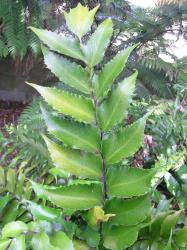Terrestrial ferns, evergreen. Rhizomes erect, scaly. Rhizome scales non-clathrate, ovate or broadly ovate, margins entire or toothed, attached at base, concolorous or bicolorous, pale brown to blackish-brown. Fronds monomorphic, not bulbiferous. Stipes and rachises scaly, adaxially sulcate. Laminae 1‑pinnate, coriaceous, scaly. Veins reticulate with free included veinlets. Sori round, borne on abaxial surface, away from the margins, in 1 to several rows either side of midrib; indusia round, peltate. Spores monolete; perispores tuberculate or reticulate, smooth on the surface.
A genus of 35 species included in subfamily Dryopteridoideae (PPG 1 2016).
Cyrtomium is assumed to be monophyletic and sister to Polystichum. The polystichoid ferns are sister to the dryopteroid ferns, comprising Arachniodes and Dryopteris (Liu et al. 2016).
Only one naturalised species, Cyrtomium falcatum, occurs in New Zealand, first recorded by Brownsey (1981).
In New Zealand the sole species of Cyrtomium can be recognised by its terrestrial habit, erect rhizome, 1-pinnate scaly frond, reticulate venation, and sori protected by round indusia that are arranged in several rows either side of the midrib. The spores are tuberculate to reticulate with a smooth surface (Large & Braggins 1991).
Cyrtomium is a genus of warm temperate regions in the Old World. The greatest diversity is in south-west China, with a few species extending to southern Africa, southern India, and Japan; 31 species in China (Zhang & Barrington 2013), one native species in Africa and Madagascar (Roux 2009), and one native species in Hawai‘i (Palmer 2003); one widespread naturalised species in North America, Europe, southern Africa, Reunion, Hawai‘i, Australia and New Zealand.
| Category | Number |
|---|---|
| Exotic: Fully Naturalised | 1 |
| Total | 1 |
The base chromosome number in Cyrtomium is x = 41 (Löve et al. 1977).




